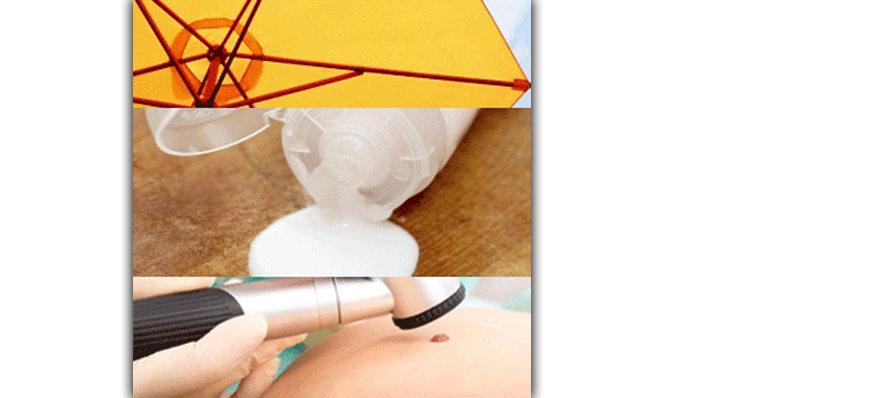Mole mapping can catch changes that are so subtle they may not be visible to the naked eye. And early detection significantly increases the chances of a complete cure.
THE “MOLE” YOU KNOW, THE SAFER YOU ARE!
What is Mole Mapping?
Mole Mapping is a painless, non-invasive procedure. Photographs are taken of your whole body to generate a complete, standard and reproducible map of the positions and appearances of moles, growths and other lesions. Their presence is meticulously documented. Your doctor then identifies and zooms in on suspicious lesions using another non-invasive tool called a dermoscope. A recommendation is made for: repeat check ups at set intervals depending on the level of suspicion; or, if needed, a biopsy, removal and/or other treatment.In follow-up examinations, your mole map provides your doctor with a highly accurate tool to detect any changes — before they are visible to the naked eye — that might be or lead to skin cancer. It is this ability to spot even minute changes that you would probably miss at home or even at a visit to the doctor that makes mole mapping so valuable. The earlier changes are detected, the more you increase the chances of identifying skin cancer or possible skin cancer, and the higher your chances of a cure.
Walk Me Through A Mole Mapping.
Q: What should I wear to an appointment?A: Clothes that are easy to get in and out of and minimum to no jewelry. Avoid very tight garments that might leave marks on your skin. You will be provided with a gown for the procedure.Q: How long does a mole mapping take?A: The initial mole mapping usually takes about an hour. It may take longer if you have many moles and other lesions. Follow-up sessions are usually faster at about half an hour.Q: Is the procedure safe? Does it hurt?A: Both mole mapping and skin cancer screening are non-invasive, painless and safe for pregnant women (they are mostly visual procedures).Q: How do I learn my results?A: While largely dependent on your doctor’s clinic and lab,you can usually expect results within two weeks. Findings typically include: your level of risk for melanoma/non-melanoma skin cancers; recommendations regarding lesions that may need to be attended to by your doctor or a dermatologist, Mohs surgeon or dermatopathologist; as well as general advice about improved safety and when you should have your next mole mapping.Q: What if something suspicious is found?A: Your general practitioner will work with or refer you to a specialist to decide on the appropriate course of action based on your results. If you require treatment, do not wait! Contact your doctor/s immediately to set an appointment and get started — acting fast can make a big difference.Q: Is it 100% accurate?A: By combining tools that are proven to help detect early melanoma (total body photography, digital dermoscopy and digital sequential monitoring), early stage melanoma and other skin cancers are detected to a high rate of accuracy. However, no method is 100% guaranteed. It is therefore very important to continue self monitoring, seeing your dermatologist regularly, avoiding the sun and using sunscreen to ensure that you are doing everything you can to prevent and help identify skin cancers as early as possible.Q: How often should I get mole mapped?A: Your results include your level of risk. For Low risk patients, an annual mole mapping is generally recommended; Moderate risk, every 6 months; and High risk, after 3 months or earlier. In between mole mapping appointments, continue to self monitor monthly and don’t forget to shun the sun and use protection daily.
When Should I Get A Mole Mapping and/or Skin Cancer Screening?
Even if you are religious about avoiding the sun, using sun protection and observing your moles and pigmentations, you should get an annual skin cancer screening and ask your doctor about mole mapping if you:
- Have a mole that has been changing in size, shape, or color, or one that is itchy or bleeding
- Have many moles
- Have moles on the back, which may be difficult to keep an eye on
- Your moles tend to be of different or unusual sizes, shapes, and/or colors
- You notice a new skin growth, spot or lesion, particularly if it does not disappear and/or seems to be growing or changing
- Were exposed to a lot of unprotected sun and/or got sunburns in your childhood or adolescence (or now!)
- Spend a lot of time outdoors, particularly if you are not consistently excellent about adequate and regular sunscreen use
- Have facial photodamage such as lines, wrinkles, large pores, irregular pigmentations
- Have signs of photodamage — such as dark spots or blotches or other irregular pigmentations, dilated capillaries, sun freckles and warts — on exposed areas of the neck, chest and arms
- Have used a sun bed, solarium or tanning booth
- Have a personal or family history of melanoma or any other type of skin cancer
- Have fair skin and/or light eyes (even if you do not, if anything else on this list applies to you, consider yourself a candidate)
DISCLAIMERThis VMV HYPOALLERGENICS® skintelligence article was not written by a dermatologist or licensed medical or health professional, and makes no claims to that effect, unless otherwise clearly specified elsewhere in this article. All content on this Web site, including medical opinion and any other health-related information, is for informational purposes only and should not be considered to be a specific diagnosis or treatment plan for any individual situation.For more on sun safety, see (articles related to sun care, sun skintelligence, etc. )





